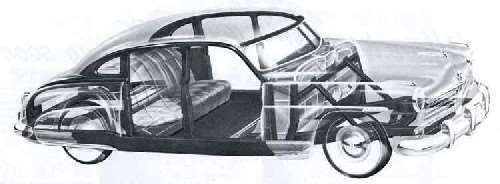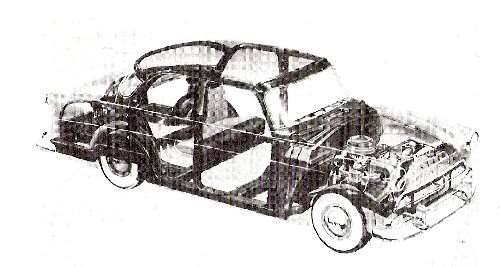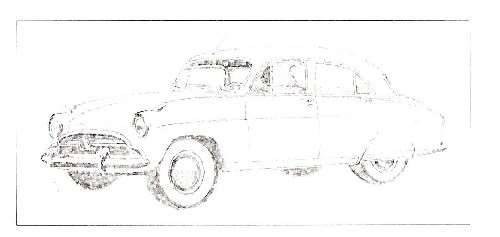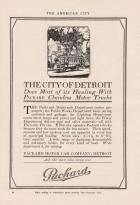|
Re: Packard & Hudson proximity
|
||||
|---|---|---|---|---|
|
Home away from home

|
Rambler proved it was possible to restyle a unibody car and so did Chrysler (after 1960).
If you ask me, the Hudson could have been restyled as easily as a body on frame car IF they had the money to pay for new tooling.
Posted on: 2014/8/22 17:45
|
|||
|
||||
|
Re: Packard & Hudson proximity
|
||||
|---|---|---|---|---|
|
Forum Ambassador

|
As I understand it, any $ Hudson might have had to rebody their cars was spent on the Jet, which was about the same as pouring it down the sink as far as success in the marketplace is concerned.
I agree with Langworth about the driving habits and comfort of the Hudsons; though our 54 Hornet Special was later modified for the drag strip, it was a very fine handling car. And you'd be lucky to find a seat in a middle-class home as comfortable as that front seat.
Posted on: 2014/8/22 18:00
|
|||
|
||||
|
Re: Packard & Hudson proximity
|
||||
|---|---|---|---|---|
|
Home away from home

|
Rambler proved it was possible to restyle a unibody car and so did Chrysler (after 1960).
Very true. If you look at the greenhouse, the 56 Rambler body carried on through 62, but with three different front clips and rear end treatments. The next generation of senior Ramblers only lasted two generations 63-64 and 65-66, with a wheelbase stretch for 65, but with the same greenhouse, before introduction of a new senior platform that spawned the Rebel (114" wheelbase) Matador (118" wb) and two generations of Ambassador (118" and 122" wb). I wonder if the engineers who figured that out were original Nash people, or Hudson people who had pondered for 5 years the problems they created with the first gen stepdown. Rambler also had a lot more volume by the late 50s then Hudson ever had, over which to amortize the tooling.
Posted on: 2014/8/22 21:08
|
|||
|
||||
|
Re: Packard & Hudson proximity
|
||||
|---|---|---|---|---|
|
Home away from home

|
As I understand it, any $ Hudson might have had to rebody their cars was spent on the Jet, which was about the same as pouring it down the sink as far as success in the marketplace is concerned.
The basic idea of the Jet was sound: compete where the big three aren't. Problem was, the same thought also occured to Nash, Kaiser and Willys, and they all got to market before the Jet. Kaiser sold almost 82,000 Henry Js in it's first year. By the time the small car market had been carved up four ways, there wasn't enough for all four to survive. I kind of like the looks of the Jet, in pictures. When I see them in the metal, I can't help but notice how tall and narrow they are. You would have thought that the Jet tooling would have found a willing buyer somewhere, like in Europe where streets are narrow, but apparently the tooling went to scrap, while Kaisers went to Argentina, the Aero went to Brazil, and, so the story goes, the Henry J tooling was on it's way to Israel (Kaiser has a small plant in Haifa) but the crates were lost in shipment along the way. And you'd be lucky to find a seat in a middle-class home as comfortable as that front seat. Rambler carried on with the coil spring seats long after others had gone to the flat zig-zag springs. When my mom was looking at new cars in 64, she objected loudly to the Olds F-85 "I'm not going to sit on the floor!" she proclaimed. The Rambler, probably thanks in part to the step down unibody design had higher seats, which suited her. Looking at the Packard Predictor, Dick Teague knew exactly where styling trends were headed. the Predictor is only 54 1/8" high, while the Packards that year stood at 62". As the Predictor is on a Clipper X frame, the seats are probably very close to the floor, probably too close for market acceptance at the time. Gaining a couple inches from a step down floorpan would have helped a lot. As for the Predictor's exterior styling, I see 58 Plymouth tailfins and a 59 Ford roof. As for the ability to fit TL in a mono-built platform, the Xray of the Jet shows a large lateral beam under the front seat, where the leveling torsion bars and drive system could be attached, and a raised platform under the rear seat that would make space for the rear axle trailing arms. The second pic is a sketch close to what was orginally planned for the Jet, before Barit tried to sit in the back seat with a hat on.
Posted on: 2014/8/22 21:36
|
|||
|
||||
|
Re: Packard & Hudson proximity
|
||||
|---|---|---|---|---|
|
Home away from home

|
Hi
Interesting discussion. "Chapin talked about the need to get out of the Hudson Jefferson plant. He said it had workflow issues, the union was agressive and the plant itself had not been maintained for 10, maybe 20, years and was in very poor material condition." One wonders how badly neglected the Hudson Jefferson Plant was by '53. If it was badly and a Packard and Hudson merger had been done in late 1953, most of the next year would have been occupied with renovating the body plant portion, unless it was a separate building. In the meantime, short-term leasing Connor Avenue only to continue body production for a year or so while consolidating assembly of both Packards and Hudsons at EGB would have been optimum. Issues of who owned what machines and tooling would have been wrangled out with Chrylser. Stamping presses they would have kepted; Contour body dies, jigs and fixtures were of no use to them. Considering what Hudson was bringing to the table, the Step-down body was obsolete, therefore a badge-engineered Hudson based on the Contour body was the best course available for 1955-57. Hudson engineering knowledge for lowered body construction was a valuable asset for future all-new '57-'58 models. In my postings above, I had dismissed the L-head sixes as over with, though have given that a re-think after running the percentages of Hudson sixes sold in 1955 and 1956. Turns out Hudson loyalist preferred them 69% for '55, and 55% for 1956 in their "Hash" Hornets and Wasps. While 1954 seems to be the end of the medium and upper-medium priced six cylinder market, Hudson and Nash proved there was still some steady demand for them. Chrysler and DeSoto had run off their last Windsor and Powermaster sixes respectively by year end. In the lower-middle, Pontiac bid adeiu to it's L-head sixes along with the straight eight. That left Dodge to soldier on against Statesmans and Wasps. It's an indication of the type customers for Dodges that the flamboyantly styled Forward Look Coronets could still be had with a 230 ci L-head six. As a way to update the Hornet/Wasp L-heads, perhaps a conversion to F-head or OHV could have been affected. By the 1960's, if Hudson Wasp was to effectively compete with Big Three full-sized six cylinder models, an OHV unit was de riguer. It would have made more sense for Packard to acquire Hudson for development into its volume medium-priced line rather than continue with Clipper. In addition to being long established with a solid customer base and dealer network, the greatest advantage would have been to allow the Packard to be luxury-priced models only. The entry-level Packard models for '55-'56 still would have been built on the 122" wb body, renamed Packard Executive as '56, priced at $3,400-$3,600. This would have opened the $2,600-$3,200 segment to be covered by Wasp and Hornet also on the 122" wb platform. A 262 ci six Wasp for priceleaders, 308 ci six Hornets as mid-range and 320 ci V8 Commodores topping off, the next price step for the upcoming young executive being a Packard appropriately named. For 1957-'58 on into the '60's, Packard was developing a perimeter frame for their new Predictor-style cars (detailed in The Cormorant over the last few years) which would have given them body architecture consistent with the Big Three. Given that tooling amortization over a range of models was necessary to every manufacturer, a Hudson-Packard model line-up would have nicely competed with Olds 88 through Cadillac Fleetwood. Although there were unibody advantages for smaller cars, the body-on-frame lent the greatest flexibility for wheelbase lengths and body configurations. Everything from a 122" wb Wasp to a 145" wb Packard Dietrich Limousine and all appropriate lengths in between, modeled on the GM B and C body program were just what they need to compete. Of Studebaker: I could get banished from the Studebaker websites for writing this but the other independents should have stood by while the South Bend company collapsed of its own mismanagement and intractable problems. This would likely have taken place in the 1957-'58 recession. With their bankruptcy, the useful assets such as the Chippewa plant, engine foundry, perhaps V8 tooling and truck-line could have been acquired by either Packard-Hudson or Nash. The foundry cast AMC blocks after Studebaker car production ended, the Chippewa plant continued with Kaiser-Jeep and eventually AM General. There was also a skilled workforce, who with an industry-parity labor contract , might have been the ideal place to produce Packard Diesel engines for the trucking and heavy equipment makers. Steve
Posted on: 2014/8/23 14:15
|
|||
|
||||
|
Re: Packard & Hudson proximity
|
||||
|---|---|---|---|---|
|
Home away from home

|
One wonders how badly neglected the Hudson Jefferson Plant was by '53.
There was a comment in this or one of the "what if" threads that a friend of a poster had interviewed for a job a Packard on EGB in 53. As he walked to the office of the person who would have been his supervisor for the second level interview, he went through dark hallways lit intermittantly by flickering flourescent lamps, with plaster falling off the ceilings and little piles of fallen plaster on the floor. Sounds like both plants were severely run down by then. renovating the body plant portion, unless it was a separate building. The Hudson body plant is a seperate building, a few miles up Conner, between Harper and Gratiot. Issues of who owned what machines and tooling would have been wrangled out with Chrylser. According to the Ward book, there was nothing to wrangle as there was no documentation at all about what Packard had transferred to Briggs. As a way to update the Hornet/Wasp L-heads, perhaps a conversion to F-head or OHV could have been affected. The Hudson sixes were crazy heavy, and long. I measured the length of the head on a Packard 359 straight 8 and a Hudson 308. The 308 is only about 2 1/2" shorter than the straight 8. Given the markets Packard and Hudson were strongest in, I wouldn't bother with a next generation six and just advertise "modern OHV V8 power standard in every model" A 262 ci six Wasp for priceleaders, 308 ci six Hornets as mid-range and 320 ci V8 Commodores topping off, The stepdown Wasp was on a 4" shorter wheelbase than the Hornet, and a couple hundred pounds lighter. I would worry about asking the 262 to pull around something as heavy as a Clipper. More likely put 308s in both, with the Twin H Power option for Hornet only. I thought about reviving the Commodore name for the V8, but that creates an entire suite of badges and interior options, while Hornet was the model with the most name recognition. Besides, the Hornet, whose 308 was more powerful than the straight 8 in the Commodore, had been outselling the Commodore by a wide margin. So I figure make the Hornet the flagship, with the 308 standard, Twin H Power 308 and V8 options. Have the Wasp differentiated by trim level and have it lag the Hornet by a year in engine options. Packard was developing a perimeter frame for their new Predictor-style cars (detailed in The Cormorant over the last few years) I would love to see a scan of a diagram of what they were considering, to see if it's what I have in mind. With their bankruptcy, the useful assets such as the Chippewa plant, engine foundry, perhaps V8 tooling and truck-line could have been acquired by either Packard-Hudson or Nash. The V8 tooling would have probably been snapped up by Nash as they needed a modern engine in the mid 200cuin range to replace a six they had that dated from the mid 30s. the ideal place to produce Packard Diesel engines for the trucking and heavy equipment makers. Packard seems to have lost interest in developing Diesels after their aborted aircraft engine venture. Quick way would have been another buyout by stock swap. Without looking up the numbers, I would expect that Cummins and Continental were too large for Packard to take over. Hall-Scott was moribund. They had been taken over by another company in 25, which didn't invest much in H-S. Outside of an aborted venture into diesels in the 30s, H-S stayed in gas engines, and was left behind after the war as trucking and marine markets moved to diesels. Unable to find a buyer for H-S, the parent company spun them off in 54. In 58, H-S was bought by Hercules for a paltry $1.7M, entirely for the spare parts business and the name That leaves Hercules itself. Herc started with diesels in the 30s and stayed with them. They had huge military contracts through the 40s and 50s and a range of both gas and diesel engines. Herc stock was selling for $19.75/share in January 52. In 36, they had 310,000 shares outstanding, so if the stock didn't split between 36 and 52, their market cap would have been a little over $6M. If they had had 1 2 for 1 split, their market cap would have been $12M, or about what it cost Packard to move final assembly into Conner. Herc was (yes, was, they failed in 1999) based in Canton, Ohio. Again, I would be looking at levering Packard's assets, as well as breaking into new markets. Would it be cost effective to have Herc's casting and forging work done in Packard's facilities on Harper? Would it have been cost effective to move engine machining and assembly into Packard's machine shops on EGB and abandon Canton entirely?
Posted on: 2014/8/23 16:08
|
|||
|
||||
|
Re: Packard & Hudson proximity
|
||||
|---|---|---|---|---|
|
Home away from home

|
Very interesting indeed. The timing of Barit's overture to Nance might have been due to Mason at some point dropping the double bomb that the Jet needed to go and Hudson large car production needed to move to Nash.
Hudson should have never found itself in the dire shape it was in when Barit approached Nance. The money spent on the Jet could have paid for a complete rework of the Hornet, and the money that this new Hornet would have brought in could have paid for the kind of Jet that would have taken off in the market - a low slung 2+2 coupe along the lines of the Italia but without its goofy oddities. Hudson did spend a lot on the '54 large cars. New fenders, hood, rear quarters, decklid, windshield, lighting, grill. This in itself proved the car could be somewhat altered visually. I couldn't help but take the styling to the next level by "fixing" what were arguably the Hornet's biggest design problems, many stated in this forum: too high a beltline, too low a greenhouse, too narrow of front doors, too short a rear overhang and too narrow a rear track. Consider this photo progression to see what was possible for 1954-56 had the Jet investment been redirected. Underhood these years could have seen the continuation of the 308 Six in addition to Packard's 320 V8. The V8 in manual form would have been quite the screamer. Maybe a special order 352 could have been made available for the racetrack.
Posted on: 2014/8/23 16:17
|
|||
|
||||
|
Re: Packard & Hudson proximity
|
||||
|---|---|---|---|---|
|
Home away from home

|
Hudson did spend a lot on the '54 large cars. New fenders, hood, rear quarters, decklid, windshield, lighting, grill.
Yup. If Barit had moved on the merger idea with Packard a year earlier, they could have saved that money, and they could have had a Clipper derived Hudson line for 54, and the unique styling elemets that started on the Clipper that year could have been diverted to Hudson. But Barit wasn't desperate in the summer of 52. While Hudson had lost $1M in 51, they made an $8M profit in 52 and the Jet hadn't bombed yet. Barit also had not seen what exactly Mason had in mind for Hudson yet.
Posted on: 2014/8/23 16:35
|
|||
|
||||
|
Re: Packard & Hudson proximity
|
||||
|---|---|---|---|---|
|
Home away from home

|
Yes, Packard-Hudson could have taken the '54 Hornet/Wasp investment and made a Clipper-based car. From Packard's perspective this would have been a good deal, pooling investment and adding volume to EGB. From Hudson's perspective I think it would have been a bad deal for two reasons. First, the Clipper would have been a good two inches higher and body-on-frame, taking away some of the most unique selling features that had kept Hudson going up to that point. And second, EGB's cost structure did not seem to support as profitably, on a per unit basis, the production of medium priced cars versus Hudson. I don't know why, I just know that Hudson had a breakeven of around 70,000 units making vehicles with lower pricing than Packard's lowest priced car, while Nance in 1952 struggled to take $150 out of the cost of the 200 to make, I think, a theoretical 100.
I know this forum is about Packard and its best interests but looking at this from Hudson's perspective, had it had its act together I would have stayed away from Packard, let them crumble then bought Utica for a song (and probably bought the Packard name from Studebaker in the early Sixties if not sooner, again on the cheap). Nor would I have done nothing but laugh at Mason and his one-sided offer to merge.
Posted on: 2014/8/23 16:51
|
|||
|
||||

 (22.76 KB)
(22.76 KB)












